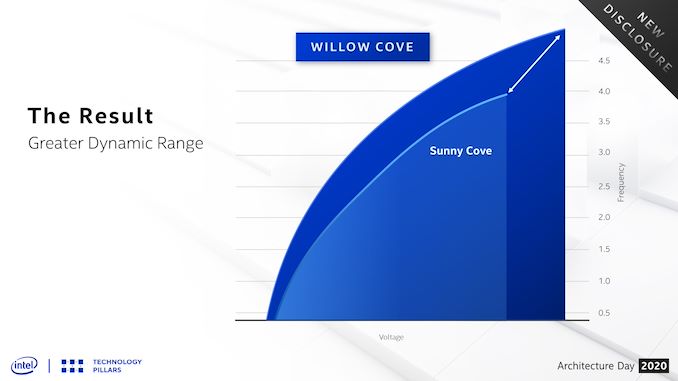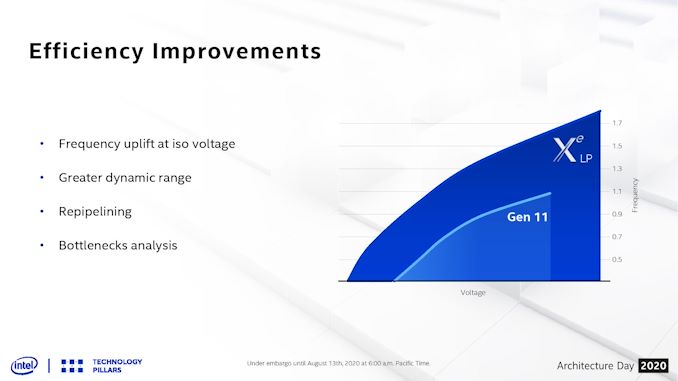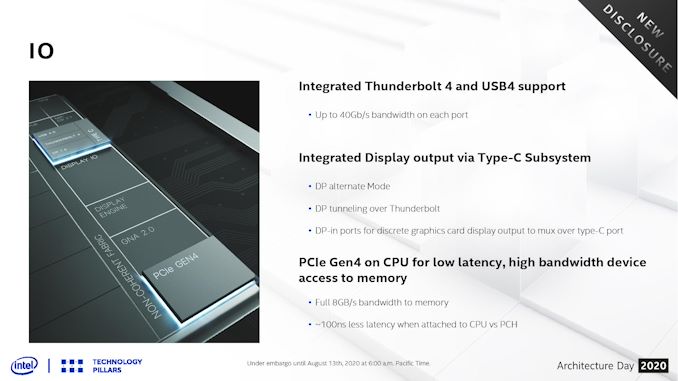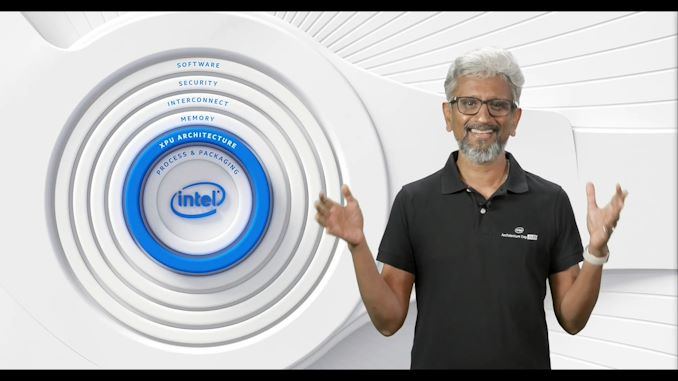Intel’s 11th Gen Core Tiger Lake SoC Detailed: SuperFin, Willow Cove and Xe-LP
by Dr. Ian Cutress on August 13, 2020 9:01 AM EST- Posted in
- CPUs
- Intel
- SoCs
- Tiger Lake
- 10+
- Xe-LP
- Willow Cove
- Intel Arch Day 2020
- SuperFin
- 10SF
Tiger Lake Performance and Products
For Tiger Lake, Intel has made some substantial changes over its previous Ice Lake design. If you’ve skipped to the end of this article without reading the pages in between, then in my opinion you should know that new 10nm SuperFin is what I would consider one of the big talking points.
SuperFin and Willow Cove Frequencies
Intel has done away with the 10+ and 10++ naming, and 10nm SuperFin (10SF) has replaced 10+.
It is called SuperFin because Intel has refined its next generation transistor fins and the metal stack in its manufacturing in order to enable a wider range of performance and efficiency compared to the base 10nm process. What this means is that Intel claims that at the same power as Ice Lake, Intel shows Tiger Lake as having a +10% frequency uplift, going from 4.0 GHz up to 4.5 GHz. Not only this, but because the new 10SF allows a wider range, when the core is pushed, Tiger Lake should move within a hair of 5.0 GHz.
That would be a +20% direct frequency uplift in peak performance, bigger than a traditional intra-node manufacturing update, before we even talk about any microarchitecture improvements.
On the core design front, comparing the new Willow Cove core to the Ice Lake core, we have very few changes. Most of it is identical, except for the L2 cache (+150%, now non-inclusive) and the L3 cache (+50%) getting bigger and new memory security measures being implemented. Intel has quoted that it went after frequency rather than IPC, as +20% frequency is more akin to a node change in performance, whereas chasing IPC in this product would not have produced the same change. As it stands, we predict a small single digit uplift in IPC. We will have to wait until the next generation product to see IPC increase again.
Xe Graphics
Tiger Lake will also be the launch vehicle for Intel’s Xe Graphics strategy. Onboard we get 96 Xe-LP execution units, up 50% from 64, running at a frequency at least 50% higher, at 1600+ MHz.
Intel is advertising the graphics performance increase over Ice Lake of around 2x all-in. Tiger Lake supports not only DDR4-3200 and LPDDR4X-4267, but LPDDR5-5400 as well, which will be good for 86.4 GB/s of bandwidth that would be great for the integrated graphics. Though it should be noted that laptop vendors aren’t jumping on the LPDDR5 bandwagon immediately, as prices are high and volumes are low / going into smartphones. LPDDR5 is going to be more of a mid-cycle update for Tiger Lake.
The Rest
On top of performance, Tiger Lake also expands its IO and Display capabilities, enabling Thunderbolt 4 natively, as well as four 4K displays and support for AV1 decode among other things. Intel states that TGL supports PCIe 4.0, and the amount of lanes will scale with core count (numbers point to an 8-core Tiger Lake in the future). Intel didn’t go into lane counts, but based on a number of pointers on Intel’s slides, we believe the four core version of the chip has a 4.0 x4 link.
The official launch for the Intel’s 11th Gen Core Mobile processors (Tiger Lake) is going to be on September 2nd. At that time we expect to see some of Intel’s OEM partners showcase product designs ahead of Q4 launches in time for the holiday season. There are still a number of questions on the chip, Intel’s ability to manufacture it, how it will compete against AMD, and so forth, which we expect to learn closer to that time.
Tiger Lake on 10 W to 65 W CPUs
As a final thought – one of the first comments made by Intel as part of our briefings was that the Tiger Lake design is going to be scalable, from 10 watts to 65 watts. The current processor we know about today is a four core processor at 15 watts. We’ve already surmised that Intel is preparing an eight core variant, with double the L3 cache, which we suspect to go up to that 65 W mark - however there is a question of where that product would end up. Traditional mobile processors tend to have a ceiling of 45-54 W TDP, and the 65 W space is usually reserved for desktop / socketed processors. Intel previously launched 65 W versions of its Broadwell mobile CPU on the desktop in 2015, and I wonder if we might see something similar here, which would enable Willow Cove, 10SF, and integrated Xe-LP on the desktop.
All of our information today came from Intel’s closed door Architecture Day 2020, held less than 48 hours prior to when this goes public. Aside from my article on Tiger Lake, and Ryan’s article on Intel’s Xe Portfolio, a number of other topics were covered, which we’ll dive into over the next few days.














71 Comments
View All Comments
Everett F Sargent - Thursday, August 13, 2020 - link
When you have epic fails at 10mn and 7nm for anything above 45W what does one do? One so-called changes their three-card Monte scheme to ... Redefining the FinFET!14++++?
Alder Lake should be renamed Lava Lake to be followed by a 10++++ desktop part circa 2030 called Hades Lake and a 7+++ part circa 2040 called Crater Lake.
In fact. all their nodes should be re-branded with Moon crater names. That way they can stop digging ever deeper holes for themselves.
TristanSDX - Thursday, August 13, 2020 - link
"As part of Architecture Day 2020, Intel also stated that the intranode update beyond 10SF will be called 10ESF," - so there won't be 10+, 10++, 10+++, but 10SF, 10ESF, 10EESF,...For me + are better
shabby - Thursday, August 13, 2020 - link
I think intel is just tired of the 14nm++++++++++ jokes so they're making a new one.jospoortvliet - Saturday, August 15, 2020 - link
So it is Enhanced Super Fins, Extra Enhanced, Enormous Extra Enhanced, Epically Enormous Extra Enhanced...Linustechtips12#6900xt - Wednesday, April 7, 2021 - link
I think you forgot about EXTREME Xtra enormous enhanced PRO MAX SUPER finsArbie - Thursday, August 13, 2020 - link
An excellent article as usual, and clearly a great deal of work. Thanks.Meteor2 - Tuesday, August 18, 2020 - link
SecondedKimGitz - Thursday, August 13, 2020 - link
I'm really waiting for Tiger Lake H which I think will go upto 8cores and feature LPDDR 5. I'm really hoping the next Microsoft Surface Book 4 will feature it and finally also support Thunderbolt for the first time. Tiger Lake H would make the Surface Book practical and functional when the screen is detached. If you look at the price tag of Surface Book they can pass on the cost of LPDDR 5 on a $3000 device. Laptops using Tiger Lake H can be paired mobile discrete GPU. The PCIe 4.0x4 available for fast NVME SSD storage directly from the CPU will bridge the gap between next gaming consoles. Booting up will be instant. Unfortunately we have to wait until 2021 for Tiger Lake H. On the other hand Chrome OS is going to really benefit from Tiger Lake U with the iGPU improving things. I expect to see a lot of Chromebooks and Chrome 2in1.Stahlkocher - Thursday, August 13, 2020 - link
How much more expensive can LPDDR5 really be? S20 series, OnePlus 8 series, Xiaomis Mi 10 (Pro) and at least one phone from Realms and Redmi do ready use LPDDR5.If that is already possible with phones it should also be possible with premium notebook designs.
KimGitz - Thursday, August 13, 2020 - link
The problem as far as I can tell is volume, mobile phones push more devices so they can benefit from the economy of scale. Samsung with their Exynos 990 and Qualcomm Sanpdragon 865 SOCs support LPDDR5 with around a dozen smartphones out (half from Samsung). Samsung who are leading in manufacturing LPDDR5 memory only uses it on their flagship mobile devices because they will sell millions of smartphones compared to laptops. Now that Intel supports LPDDR5 we will see an increased demand and roll out on laptops.